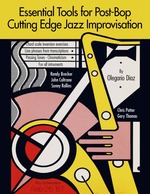Purchase the ebook for easy and immediate reading.
Purchase the print book for easy reading (3rd party vendor).
Purchase the audiobook for easy listening.
 Post-Bop is a modern jazz style that continues the distinguishing characteristics that separate jazz from the world of pop and rock; swing rhythm and extended harmonies (9th chords 11ths, altered chords, etc). Post-Bop grew out of the Hard Bop genre during the early to mid 60s as musicians such as Bill Evans, Wayne Shorter and Herbie Hancock began to introduce more extended harmonies, abstract structures and looser rhythms in their playing and compositions.
Post-Bop is a modern jazz style that continues the distinguishing characteristics that separate jazz from the world of pop and rock; swing rhythm and extended harmonies (9th chords 11ths, altered chords, etc). Post-Bop grew out of the Hard Bop genre during the early to mid 60s as musicians such as Bill Evans, Wayne Shorter and Herbie Hancock began to introduce more extended harmonies, abstract structures and looser rhythms in their playing and compositions. We have been providing authors and small presses with ebook publishing and book marketing services since 2010. We offer ebook publishing (creation, formatting, distribution), print on demand services, audiobook creation, editing/proofreading, book/author websites, and book marketing and promotion services. Please let us know how we can help you!